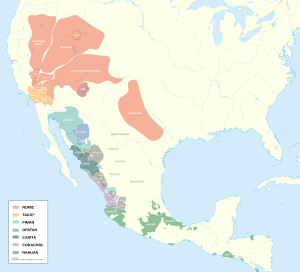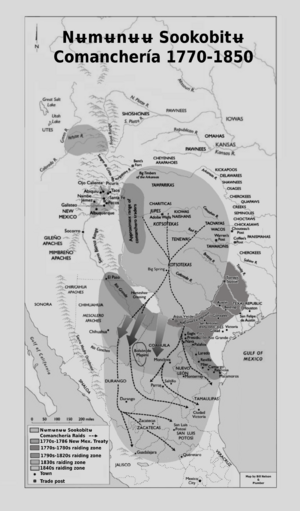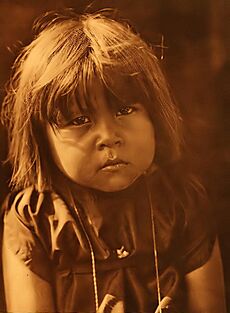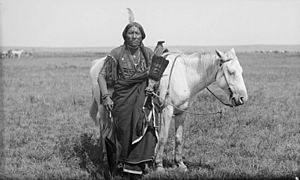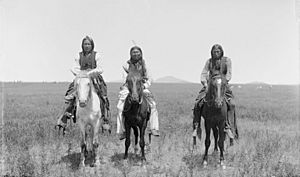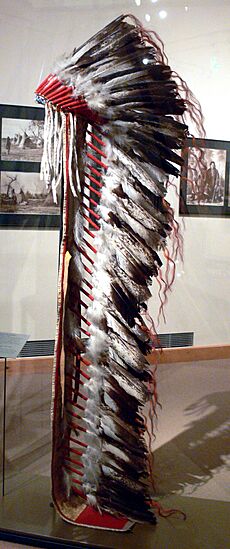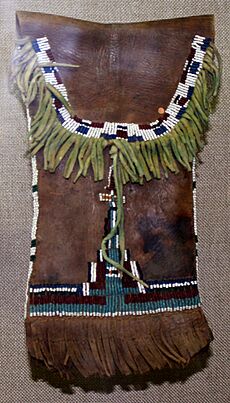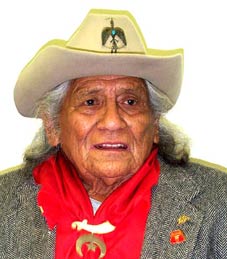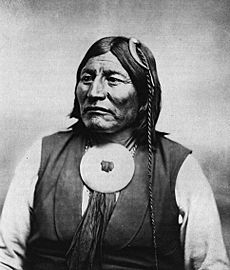Comanche facts for kids
|
Flag of the Comanche Nation
|
|
| Total population | |
|---|---|
| 17,000 enrolled Comanche Nation (2021), 28,193 self-identified, US Census (2020) |
|
| Regions with significant populations | |
| United States (Oklahoma, Texas, New Mexico) | |
| Languages | |
| English, Comanche | |
| Religion | |
| Native American Church, Christianity, traditional tribal religion | |
| Related ethnic groups | |
| Shoshone, Timbisha, and other Numic peoples |
The Comanche people, also known as Nʉmʉnʉʉ (which means "the people" in their language), are a Native American tribe. They come from the Southern Plains area of what is now the United States. Today, Comanche people are part of the Comanche Nation, which is officially recognized by the U.S. government. Their main office is in Lawton, Oklahoma.
The Comanche language is part of the Uto-Aztecan language family. It started as a dialect of the Shoshoni language but later became its own language. The Comanche were once part of the Shoshone people who lived in the Great Basin.
In the 1700s and 1800s, the Comanche lived in much of what is now northwestern Texas. Their land also included parts of eastern New Mexico, southeastern Colorado, southwestern Kansas, and western Oklahoma. Spanish settlers and later Mexicans called this area Comanchería.
During these centuries, the Comanche were known for their nomadic lifestyle and their skill with horses. They hunted, especially bison, and traded with other Native American groups. They also traded with Spanish, French, and American settlers.
As more European Americans moved into their lands, the Comanche fought to protect their territory. They also raided settlements of both settlers and other Native American tribes. They sometimes took captives during these raids. These captives might become part of the Comanche tribe, or they might be traded. Thousands of captives from Spanish, Mexican, and American settlements joined Comanche society. At one point, the Comanche language was widely spoken across the Great Plains.
Sadly, diseases brought by Europeans, the destruction of bison herds, and the loss of their land forced most Comanches onto reservations. This happened in Indian Territory by the late 1870s.
Today, the Comanche Nation has about 17,000 members. Around 7,000 of them live in areas near Lawton, Fort Sill, and other parts of southwestern Oklahoma. Every July, the Comanche Homecoming Annual Dance takes place in Walters, Oklahoma.
Contents
What's in a Name?
The Comanche call themselves nʉmʉnʉʉ, which means "the human beings" or "the people". The name "Comanche" was first used in 1706 by Spanish officials. They heard the Ute name for the Comanche, kɨmantsi, which meant "enemy". The Spanish then spelled it "Comanche". Before 1740, French explorers sometimes called the Comanche "Padouca". This was because they used the same name for the Plains Apache and didn't know a new tribe had moved into the area.
How the Comanche Nation is Governed
The Comanche Nation's main office is in Lawton, Oklahoma. Their tribal area covers parts of Caddo, Comanche, Cotton, Greer, Jackson, Kiowa, Tillman, and Harmon counties. The current Tribal Chairman is Mark Woommavovah. To be an enrolled member of the tribe, a person must have at least 1/8 Comanche blood.
Building the Economy
The Comanche Nation runs its own housing programs. They also issue special vehicle tags for tribal members. They have a Department of Higher Education that helps members pay for college. The tribe owns 10 smoke shops and four casinos:
- Comanche Nation Casino in Lawton
- Red River Casino in Devol, Oklahoma
- Comanche Spur Casino in Elgin, Oklahoma
- Comanche Star Casino in Walters, Oklahoma
Cultural Centers
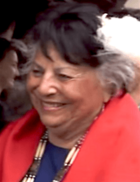
The Comanche National Museum and Cultural Center is in Lawton, Oklahoma. It has exhibits about Comanche history and culture. It opened in 2007.
In 2002, the tribe started the Comanche Nation College. This was a two-year college in Lawton. However, it closed in 2017 due to problems with its accreditation and funding.
Every July, Comanche people from all over the United States gather in Walters. They celebrate their heritage and culture at the annual Comanche Homecoming powwow. The Comanche Nation Fair happens every September. The Comanche Little Ponies group also hosts two annual dances: one around New Year's Eve and one in May.
Comanche History
How the Comanche Formed
The Comanche moved to the Plains as part of a larger movement of Shoshonean-speaking people. The Kotsoteka group was likely among the first to move. They kept in touch with the Shoshones in Wyoming until the 1830s.
After the Pueblo Revolt in 1680, many Plains peoples got horses. The horse became very important to the Comanche way of life. Some historians believe the Comanche left the Shoshone and moved south to find more horses from settlers in New Spain. The Comanche were one of the first Plains groups to use horses for a long time. They had horses even when the Cheyenne still lived in earth lodges.
The Comanche became known for supplying horses and mules to everyone. By the mid-1800s, Comanche horses were being traded far away.
Their journey brought them to the southern Great Plains. This land stretched from the Arkansas River to central Texas. The first Spanish records mentioning them are from 1706. The Comanche were strong warriors. They developed ways to fight on horseback using traditional weapons. Warfare was a big part of their lives. Comanche raids into Mexico often happened during the full moon. This allowed them to ride at night. These raids, especially in the 1840s, went deep into Mexico and caused a lot of damage.
Comanche Groups
Traditional Comanche society had different levels of groups. The smallest was the family. Then came larger family groups who lived together. The main social unit was the "band," which could have several hundred people. These bands were family-based, centered around related men. The leader was called 'paraivo', or 'chief'.
Unlike the Cheyenne and Arapaho, the Comanche never had one single "Nation" that all groups followed. Instead, different divisions (larger groups of bands) acted on their own.
The Spanish first identified three main Comanche divisions: Hʉpenʉʉ, Yaparʉhka, and Kʉhtsʉtʉhka. Over time, these groups changed. The Kʉhtsʉtʉhka, or 'Buffalo Eaters', were likely the first to separate from the Eastern Shoshones.

The Hʉpenʉʉ group disappeared by the early 1800s. They likely joined other groups like the Nokoni Nʉʉ and Kwaarʉ Nʉʉ. Many Yaparʉhka moved southeast and became known as the Tahnahwah. Other powerful groups like the Nokoni Nʉʉ ('wanderers') and Kwaarʉ Nʉʉ ('Antelope Eaters') also grew.
The northernmost Comanche group was the Yaparʉhka ('Root-Eaters'). They kept many Eastern Shoshone traditions. Some groups from other tribes, like the Arapaho and Plains Apache, joined the Comanche.
Texans and Americans often divided the Comanche into five main bands: the Yaparʉhka, Kʉhtsʉtʉhka, Nokoni Nʉʉ, Penatʉka Nʉʉ, and Kwaarʉ Nʉʉ. These were then grouped by where they lived: Northern, Middle, Southern, and Western Comanche.
- The "Northern Comanche" included the Yaparʉhka and Kʉhtsʉtʉhka. They lived in the high plains of Oklahoma and Texas.
- The "Middle Comanche" included the Nokoni Nʉʉ, Tahnahwah, and Tanimʉʉ. They lived between the Red River and the Colorado River.
- The "Southern Comanche" were the Penatʉka Nʉʉ ('Honey Eaters'). They were the largest group and lived closest to Spanish and Texan settlements.
- The "Western Comanche" were the Kwaarʉ Nʉʉ ('Antelope Eaters'). They lived in the desert plains of eastern New Mexico and western Texas. They were the last group to give up fighting.
There can be confusion with Comanche group names because families, bands, and divisions all had names. Also, there were nicknames and different spellings in Spanish and English.
Comanche Wars
The Comanche fought many wars against Spanish, Mexican, and American armies. They were known as fierce warriors who bravely defended their homeland, Comancheria. However, the large number of settlers moving in and the diseases they brought caused the Comanche's power to decline.
Relations with Settlers

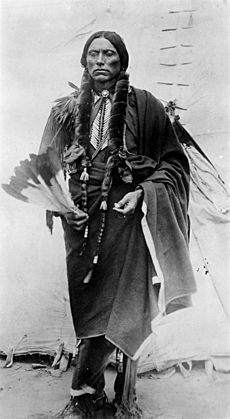
The Comanche had a complex relationship with Europeans and settlers. They were good trading partners with the Comancheros from New Mexico, but settlers in Texas feared their raids. They also fought with almost every other Native American group on the South Plains. This created chances for European powers and the United States to get involved. Sam Houston, the president of the new Republic of Texas, almost made a peace treaty with the Comanche in 1844. But the Texas government refused to create a clear border for Comancheria.
Even though the Comanche kept their independence for a while, they faced a huge threat by the mid-1800s. Waves of diseases like smallpox and cholera, which they had no protection against, killed many people. The Comanche population dropped from about 20,000 in the late 1700s to only a few thousand by the 1870s.
In the late 1860s, the U.S. government tried to move the Comanche to reservations. The Treaty of Medicine Lodge (1867) offered them churches, schools, and money in exchange for a huge amount of land. The government promised to stop buffalo hunters, who were killing off the large herds. In return, the Comanche and other tribes agreed to move to a much smaller reservation. However, the government did not stop the buffalo slaughter.
The Comanche, led by Quenatosavit White Eagle, fought back by attacking hunters in Texas in 1874. This attack was not successful for the Comanche. The U.S. army then stepped in during the Red River War to force the remaining Comanche onto the reservation. This ended with the Battle of Palo Duro Canyon. Within just 10 years, the buffalo were almost gone. This ended the Comanche way of life as hunters. In May 1875, the last free group of Comanches, led by the warrior Quanah Parker, surrendered. They moved to the Fort Sill reservation in Oklahoma.
By 1890, the census showed only 1,598 Comanche people at the Fort Sill reservation.
Meusebach–Comanche Treaty
The Peneteka band made a peace treaty with the German Immigration Company in 1847. This treaty was not with any government. It allowed Germans to settle lands in Texas. The treaty was signed in Fredericksburg, Texas. It was only between the Peneteka band and the German company. By 1875, the Comanches had been moved to reservations.
Cherokee Commission
Another agreement in 1892, signed with the Cherokee Commission, further reduced the Comanche reservation. It gave each person 160 acres of land. The rest of the land was opened up for white settlers. This ended the time of the Comanche reservation.
Captive Herman Lehmann
One famous captive in Texas was a German boy named Herman Lehmann. He was first taken by the Apaches, then escaped and was found by the Comanches. Lehmann became the adopted son of Quanah Parker. In 1901, Quanah Parker officially stated that Lehmann was his adopted son. In 1908, the U.S. Congress gave Lehmann 160 acres of land in Oklahoma.
Recent History

It was hard for the Comanche to join the Western economy in the late 1800s and early 1900s. Many tribal members lost their land and belongings unfairly. Chief Quanah Parker was appointed as the main chief by the U.S. government. He worked hard to get better deals for his people. He often met with politicians in Washington. He also helped manage land for the tribe.
Parker became wealthy as a cattle rancher. He also fought for the Comanche to be allowed to practice their Native American Church religious rites, like using peyote. This was something European Americans often disagreed with.
During World War II, many Comanche left their traditional lands in Oklahoma. They looked for jobs and new chances in cities in California and the Southwest. About half of the Comanche population still lives in Oklahoma, mostly around Lawton.
Recently, an 80-minute silent film from 1920 was found again. It is called The Daughter of Dawn. It features over 300 Comanche and Kiowa actors.
Comanche Culture

Childbirth and Naming

When a Comanche woman was having a baby in camp, she moved to a tipi or a brush lodge. Older women helped her as midwives. Men were not allowed inside during or right after the birth.
After the baby was born, the midwives hung the umbilical cord on a hackberry tree. People believed that if the cord was not touched until it rotted, the baby would live a long and happy life.
The newborn was swaddled and stayed with its mother for a few days. Then the baby was placed in a cradleboard. This made it easy for the mother to carry the baby on her back or prop it up while she worked. Cradleboards had a flat board with a basket or leather pouch attached. Babies stayed in them for about ten months.
Both girls and boys were welcomed, but boys were especially favored. If a boy was born, the family might paint a special design on their tipi. This showed the tribe they had a new warrior. Sometimes a father named his child, but often he asked a medicine man or another respected person to do it. They hoped the child would have a long and good life. During the naming ceremony, the medicine man prayed for the child's happiness and health. He lifted the child and said the name four times, a little higher each time. It was believed that the child's name could predict their future. Boys were often named after grandfathers or uncles. Girls were usually named by their mothers after a female relative. As children grew, they also got nicknames.
Growing Up Comanche
The Comanche saw their children as their most precious gift. Children were rarely punished. Sometimes, an older relative or a "boogey man" might be used to scare a disobedient child. Children were also told about Big Maneater Owl, who lived in the Witchita Mountains and ate bad children.
Children learned by watching and listening to their parents and others. As soon as a girl could walk, she followed her mother. She played at cooking and making clothes. She was also very close to her mother's sisters, whom she called "mother." She was given a small deerskin doll and learned to make clothes for it.
A boy looked up to his father and the bravest warriors. He learned to ride a horse before he could walk. By age four or five, he was expected to handle a horse well. At five or six, he got a small bow and arrows. Often, his grandfather taught him to ride and shoot. His grandfather also shared stories of his own youth and Comanche history.
As boys got older, they hunted birds together. They learned to be patient and quiet hunters. This helped them become self-reliant. Playing together also built the teamwork they would need for hunting and raiding.
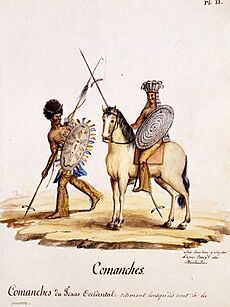
Boys were highly respected because they would become warriors. They might die young in battle. When a boy was ready, he went on his first buffalo hunt. If he made a kill, his father honored him with a feast. Only after proving himself on a buffalo hunt could a young man go to war.
Around age 15 or 16, a young man would go on a vision quest. This was a special journey to find his spiritual power. After this, his father gave him good horses for battle. If he proved himself as a warrior, a Give Away Dance might be held for him. During this dance, his family and others threw gifts at his feet, especially blankets and sticks representing horses. People often gave away all their belongings to help others in the band.
Girls learned to gather berries, nuts, and roots. They carried water and collected wood. Around age 12, they learned to cook, make tipis, sew clothes, prepare animal hides, and other tasks needed to be a wife and mother. They were then considered ready for marriage.
Burial Customs
In the 1800s, the Comanche wrapped a deceased person's body in a blanket. They placed it on a horse behind a rider. The rider would then find a safe burial place, like a cave. After placing the body, the rider covered it with stones. Back in camp, mourners burned all the deceased's belongings. The main mourner might cut their arms to show grief. The Quahada band kept this custom longer than others. They buried their relatives in the Witchita Mountains. Today, Christian missionaries have encouraged Comanche people to bury their dead in coffins in graveyards.
Travel and Homes
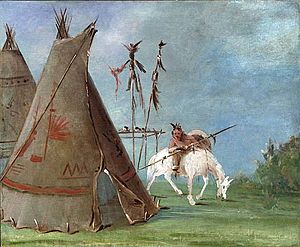
When they lived with the Shoshone, the Comanche mostly used dog-drawn travois for travel. Later, they got horses from other tribes and the Spanish. Horses were faster, easier to control, and stronger. This helped them with hunting, warfare, and moving camp. They could also build larger homes because horses could carry more belongings. Horses were also easier to feed than dogs.
Horses were extremely valuable to the Comanche. A man's wealth was measured by how many horses he owned. Stealing horses was a main goal during raids. Often, hundreds of horses were stolen by the Comanche from other tribes and settlers. Horses were used for warfare, and the Comanche were known as some of the best mounted warriors in history.

The Comanche covered their tipis with buffalo hides sewn together. Women prepared the hides by scraping off fat and hair, then soaking and softening them. They were then smoked to a tan color. It took about 14 to 22 hides to make a tipi cover. The cover was tied to a pole, wrapped around a cone-shaped frame, and pinned with wooden skewers. Two flaps at the top could be adjusted to keep out rain and hold warm air. With a fire pit inside, tipis stayed warm in winter. In summer, the bottom edges could be rolled up for a breeze. Tipis were perfect homes for nomads. Women could set them up or take them down quickly. An entire Comanche band could pack up and be ready to chase buffalo in about 20 minutes. Women did most of the food preparation.
Food and Diet
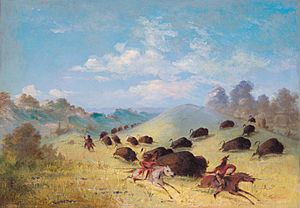
The Comanche were originally hunter-gatherers. When they moved to the Plains, hunting became most important. Hunting was a male activity and brought great respect. For meat, they hunted bison, elk, black bear, pronghorn, and deer. If game was scarce, they hunted wild mustangs or even ate their own ponies. Later, they raided Texas ranches for longhorn cattle. They usually did not eat fish or birds unless they were starving.
Women prepared and cooked meat. They also gathered wild fruits, seeds, nuts, berries, and roots. These included plums, grapes, juniper berries, persimmons, mulberries, acorns, pecans, wild onions, and radishes. They also got maize, dried pumpkin, and tobacco through trade and raids. They roasted meat over a fire or boiled it. To boil food, women dug a pit, lined it with animal skins, filled it with water, and added hot stones to make it boil. After contact with the Spanish, they used copper pots and iron kettles.
Women used berries, nuts, honey, and tallow to flavor bison meat. They stored tallow in animal intestines or rawhide pouches. They especially liked a sweet mush made of bison marrow mixed with crushed mesquite beans.
The Comanches sometimes ate raw meat, especially raw liver with gall. They also drank milk from bison, deer, and elk udders. A special treat was curdled milk from the stomachs of baby bison. They also enjoyed bison stomachs.
Comanche people usually ate a light breakfast and a large dinner. They ate during the day when hungry or when it was convenient. Like other Plains tribes, the Comanche were very welcoming. They prepared meals whenever a visitor arrived. Many families gave thanks before eating.
Comanche children ate pemmican, a high-energy food. It was mostly saved for war parties or when other food was scarce. Traders called pemmican "Indian bread" when sliced and dipped in honey.
Clothing and Style
Comanche clothing was simple. Men wore a leather belt with a breechcloth (a long piece of deerskin) and loose deerskin leggings. Their Moccasins had tough buffalo hide soles and soft deerskin tops. Men wore nothing on their upper body, except in winter. Then, they wore heavy buffalo hide robes and knee-length buffalo-hide boots. Young boys usually wore no clothes unless it was cold. By age 8 or 9, they wore adult clothing. In the 1800s, men started using woven cloth instead of buckskin for breechcloths and wore buckskin shirts.
Women wore long deerskin dresses with wide sleeves and fringes. They decorated their clothes with beads and metal pieces in geometric patterns. Women wore buckskin moccasins with buffalo soles. They also decorated their clothes with fringes, fur, and human hair. In winter, they wore warm buffalo robes and tall, fur-lined buffalo-hide boots. Girls old enough to walk wore breechcloths. By age 12 or 13, they wore women's clothing.
Hair and Headgear
Comanche people were proud of their long hair. They parted it in the middle and painted the scalp along the part with colored clay. They wore their hair in two long braids, often tied with leather or cloth. They also braided a thin strand from the top of their head, called a scalp lock. This was decorated with cloth, beads, and a single feather. Comanche men rarely wore anything on their heads. Only after moving to reservations did they start wearing the typical Plains headdress. In very cold weather, they might wear a brimless buffalo hide hat. Some warriors wore a buffalo scalp headdress during war. This type of hat was unique to the Comanche.
Women did not grow their hair as long as men. Young women might wear long braids, but older women parted their hair in the middle and kept it short. Like men, they painted their scalp along the part with bright paint.
Body Decoration
Comanche men often had pierced ears with earrings made of shell or metal. A female relative would pierce the outer edge of the ear. Men also tattooed their face, arms, and chest with geometric designs. They painted their face and body using berry juice and colored clays. Later, traders sold them bright paints. Men wore leather bands and metal strips on their arms. There was no standard color or pattern for face and body painting. It was up to each person. Some designs had special meaning or came from dreams.
Women might also tattoo their face or arms. They enjoyed painting their bodies. It was popular for women to paint the insides of their ears bright red. They also painted large orange and red circles on their cheeks and red and yellow around their lips.
Art and Tools
Because they moved often, the Comanche needed strong household goods. They did not use pottery, which could break easily. They did not do weaving, wood carving, or metal working. Instead, they used buffalo for most of their tools and weapons. They made almost 200 different useful items from buffalo horns, hides, and bones.
Women used the lining of the buffalo stomach to make water bags or cooking pots. Since wood was scarce, women used buffalo chips (dried dung) for cooking and heat.
Stiff rawhide was used for saddles, stirrups, knife cases, buckets, and moccasin soles. Rawhide was also made into rattles and drums. Strips of rawhide were twisted into strong ropes. Scraped rawhide skins were folded to make parfleches. These were pouches for food, clothing, and other items. Women also tanned hides to make soft buckskin. This was used for tipi covers, robes, blankets, clothes, and moccasins. They used buckskin for bedding, cradles, dolls, bags, and quivers.
Sinew (tendons) was used for bowstrings and sewing thread. Hooves were turned into glue and rattles. Horns were shaped into cups, spoons, and ladles. The tail was used as a whip or fly-swatter. Men made tools, scrapers, needles, pipes, and toys from bones. But men mainly focused on making bows and arrows, lances, and shields. The thick neck skin of an old bull was perfect for war shields that could stop arrows and even bullets. Since they spent most of their day on horseback, they also made leather saddles and other horse equipment. Buffalo hair was used to fill saddle pads and for ropes.
Language
The language spoken by the Comanche people is called Comanche (Nʉmʉ tekwapʉ). It is a Numic language from the Uto-Aztecan language group. It is closely related to the Shoshone language. The Comanche language separated from Shoshone around 1700. The two languages are still similar, but some small sound changes make it hard for speakers of one to understand the other. Early records from 1786 show Comanche as a Shoshone dialect. But by the early 1900s, these sound changes had made Comanche sound quite different.
Today, efforts are being made to keep the language alive. However, most speakers are elderly, and less than 1% of Comanches can speak it.
In the late 1800s, many Comanche children went to boarding schools with children from different tribes. They were taught English and were not allowed to speak their native language. It is said that enforcing English was very strict.
Quanah Parker learned and spoke English. He insisted that his own children do the same. Because of this, the next generation grew up speaking English. Many believed it was better for them not to know Comanche.
Comanches were among the first Native Americans used as code talkers by the U.S. Army during World War I.
During World War II, a group of 17 young Comanche men were trained as "Comanche code talkers." They were used by the U.S. Army to send secret messages that the Germans could not understand.
Famous Comanche People
- Further information: Category:Comanche people
Historic Comanche Leaders
These are notable Comanche people from the 1700s and 1800s.
- Buffalo Hump (c. 1800 – c. 1865/1870), a war chief and later head chief of the Penateka group.
- Horseback (c. 1805/1810 – c. 1888), chief of the Nokoni band.
- Iron Jacket (c. 1790 – 1858), a war chief and later head chief of the Quahadi band; father of Peta Nocona.
- Mow-way (c. 1825 – 1886), a Kotsoteka chief.
- Peta Nocona (c. 1820 – c. 1864), chief of the Quahadi group; father of Quanah Parker.
- Quanah Parker (c. 1845 – 1911), a Quahadi chief, a founder of the Native American Church, and a rancher.
- Ten Bears (c. 1790 – 1872), chief of the Ketahto band and later of the entire Yamparika group.
- Tosawi (c. 1805/1810 – c. 1878/1880), chief of the Penateka band.
Famous Comanche Captives
- Cynthia Ann Parker (1827–1863), an American captive, wife of Peta Nocona, and mother of Quanah Parker.
- Herman Lehmann (1859–1918), a German boy captured by Apaches and later adopted by Quanah Parker.
Modern Comanche Citizens

These are Comanche Nation citizens from the 1900s and 2000s.
- Charon Asetoyer (born 1951), an activist for women's health.
- Charles Chibitty (1921–2005), a World War II Comanche code talker.
- Karita Coffey (born 1947), a ceramic artist, professor, and sculptor.
- LaDonna Harris (born 1931), a political activist and founder of Americans for Indian Opportunity.
- Janee' Kassanavoid (born 1995), an athlete who competes in the hammer throw.
- Doc Tate Nevaquaya (1932–1996), a Flatstyle painter and Native American flute player.
- Paul Chaat Smith, a Comanche/Choctaw author and museum curator.
- George Tahdooahnippah (born 1978), a professional boxer known as "Comanche Boy."
Population Changes Over Time
In 1832, Comanche chiefs told George Catlin that their tribe had up to 40,000 people. They said they could gather up to 8,000 warriors. In 1786, the Spanish thought the Comanche might number up to 30,000. Other estimates in the early 1800s were also high, around 38,000 to 41,000.
However, the Comanche population dropped quickly in the second half of the 1800s. The census of 1890 found only 1,598 Comanche people in Oklahoma. By 1910, the census reported only 1,171.
The Comanche population has grown again in the 1900s and 2000s. The census of 2020 found 28,193 Comanches in the USA.
See also
 In Spanish: Comanche (etnia) para niños
In Spanish: Comanche (etnia) para niños



